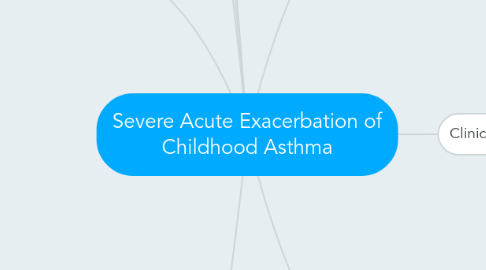Severe Acute Exacerbation of Childhood Asthma
by Monchee Y

1. Causes
1.1. Allergies
1.2. Smoking
1.3. Environment
1.4. Obesity
1.5. Pregnancy
1.6. Stress
1.7. Genes
1.8. Airway Hyperactivity
1.9. Atopy
2. Clinical Manifestations
2.1. Tachypnea
2.2. Difficulty in breathing
2.3. Use of accessory muscles
2.4. Nasal flaring
2.5. Diaphoresis
2.6. Anxiety
2.7. Wheezing
3. Diagnostic Procedures
3.1. Blood tests
3.2. Chest radiography
3.3. Arterial blood gases
3.4. Electrocardiogram
3.5. Pulmonary function tests
3.5.1. Peak Flow
3.5.2. Partial Pressure of Carbon Dioxide
3.5.3. FEV1
3.5.4. Oxygen Saturation
3.5.5. PAO2
4. Pathogenesis
4.1. Exposure to Allergens
4.1.1. Allergen reaches trachea or bronchi
4.1.1.1. Dendritic cells
5. Management
5.1. Non-invasive positive pressure ventilation
5.2. Bronchodilators
5.3. Steroids
5.4. Antihistamines
5.5. Inhaled short acting B2-agonist
6. Aetiology
7. Prognosis
7.1. Patients appear agitated or drowsy and have dyspnoea at rest; infants stop feeding due to the increased work of breathing and altered mental state. Cyanosis may also be present. Patients either talk in words or are unable to talk. The respiratory rate is increased, and heart rate may be increased or decreased (a pre-terminal sign). Marked accessory muscle use is present with suprasternal retractions and possible thoraco-abdominal movement. Wheeze is usually loud but may be absent (silent chest). SaO2 is less than 90%, and the PEFR (or FEV1) is 26% to 39% (severe) or less than 25% (life-threatening) predicted or percentage of personal best.
7.2. All patients should be admitted to hospital. Oxygen therapy, nebulised short-acting beta-2 agonists, and systemic corticosteroid therapy should be started immediately. Continuous nebulisation of short-acting beta-2 agonists is superior to intermittent administration. [B Evidence] Frequent administration of beta-2 agonist can cause transient decreases in potassium, magnesium, and phosphate levels. Potassium levels should be monitored in all children receiving regular beta-2 agonist therapy and replaced as required. In children unable to tolerate oral corticosteroid therapy, or where adherence is a significant concern, another alternative is intramuscular (IM) dexamethasone, which has been shown to be comparable to a 5-day course of oral prednisolone (2 mg/kg/day) in 2 paediatric RCTs (total n = 292). [30] [31]
7.3. In severe asthma, inhaled anticholinergics should be given in conjunction with short-acting beta-2 agonists, and if the response remains inadequate, then intravenous bronchodilators (beta-2 agonists [B Evidence] or theophylline [B Evidence] ) and intravenous magnesium sulfate should be considered. [A Evidence] There is some evidence to suggest that inhaled MgSO4 may be useful in severe asthma exacerbations, but further studies are required before any firm recommendations can be made. [48]
7.4. While most severe asthma is not related to anaphylaxis and does not require intramuscular epinephrine (adrenaline), intramuscular epinephrine (adrenaline) should be considered if signs of anaphylaxis are present.
7.5. Antibiotic therapy is generally not required and is reserved for cases in which bacterial infection is the trigger.
7.6. The anaesthetic or paediatric intensive care team needs to be involved. If there are signs of impending respiratory failure (confusion or marked agitation, loss of respiratory effort, pulsus paradoxus, cyanosis, hypoxaemia, or respiratory acidosis) despite intravenous bronchodilators and magnesium sulfate, patients may require intubation and mechanical ventilation with 100% oxygen.
8. Prevention
8.1. Advise parents to ensure babies and children are not exposed to cigarette smoke.
8.2. If a family already has pets, it is not necessary to remove them unless the child develops evidence of pet allergy and this is confirmed by skin-prick testing.
8.3. In children without demonstrated specific hypersensitivities, do not routinely recommend allergen avoidance measures for the purpose of reducing the child’s risk of developing asthma.
8.4. Advise parents of children at risk of asthma that damp, mouldy home environments may increase asthma risk in children with genetic predisposition to asthma and should be avoided if possible (e.g. by ventilation and mould removal), but that there is not clear evidence that anti-mould strategies will prevent asthma.
8.5. Advise parents that children’s risk of developing asthma may be increased by various types of indoor and outdoor pollution (e.g. unflued gas heaters, traffic pollution).
8.6. Advise parents to give children paracetamol at recommended doses when necessary to reduce fever (according to current guidelines for managing fever) and for pain relief when needed (according to current guidelines for managing pain in children), but to avoid unnecessary or frequent paracetamol use
8.7. For children with allergies and family history of asthma, offer referral to a clinical immunologist or allergist for assessment for specific immunotherapy.
8.8. In children with atopic dermatitis or allergic rhinitis, manage according to current guidelines (using antihistamines, if indicated) but do not prescribe or recommend long-term antihistamine use specifically for the purpose of reducing the child’s risk of developing asthma.


